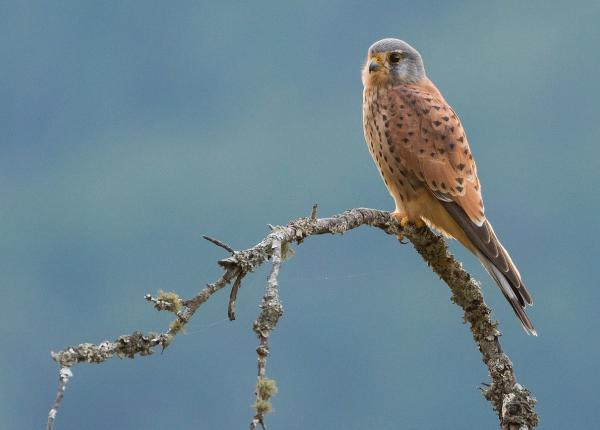Did You Know?
- There are twelve recognized subspecies of the Eurasian Kestrel
- In 1982, Dr. Tom Cade, founder of The Peregrine Fund, stated that this falcon was "probably the most numerous species of Falco in the world."
How The Peregrine Fund is Helping
Though The Peregrine Fund does not work directly with Eurasian Kestrels, our efforts in scientific research, habitat conservation, education, and community development help conserve birds of prey around the world. We also supply literature to researchers from our avian research library, which helps scientists around the world gather and share important information on raptor conservation. Additionally, our support of the Global Raptor Information Network gives raptor researchers tools to more efficiently conduct their own studies while contributing to a global program. It also provides citizen scientists a way to participate in raptor science and conservation.
Where It Lives
The Eurasian Kestrel is found throughout much of Europe, Asia, and into Africa. Throughout their range hey can be found in a variety of habitats including urban parks, orchards, small woodlands, palm groves, gorges, and ravines, taiga and forest tundra, semi-arid desert steppes, and agricultural fields.
What It Does
This lovely falcon often spends time on high cliffs, telephone poles, electric lines, and even electricity pylons, where it often perches while hunting. It isn't a gregarious species and is usually seen alone, or in pairs. Researchers have observed that this kestrel is not particularly wary of humans.
As you may know, most birds of prey have amazing eyesight. Studies have found that Eurasian Kestrels, like some other birds, can see ultraviolet light, which is invisible to the human eye. This ability helps them find and catch prey. This does not mean that kestrels see animals that we don’t, but they do see rodents' urine trails, which reflect ultraviolet light. To a kestrel, these urine trails are like neon arrows pointing to their favorite restaurant. Kestrels might even set up a territory in an area with lots of urine trails because this means there are lots of tasty meals running around.
Why It Needs our Help
The Eurasian Kestrel is categorized as a species of Least Concern. It is considered one of the most common raptors throughout its wide range. However, not everything bodes well for the future of the Eurasian Kestrel. Its populations in some parts of its range easons for the decline are not clear, but it may be related to agricultural intensification of farmland habitats and the resulting decline of small mammal poulations. Categorized globally as a species of "Least Concern" by BirdLife International
What It Eats
Like many other kestrel species, the Eurasian Kestrel feeds mainly on insects. However, it will also feast upon a wide variety of small birds, rodents, and reptiles.
It employs a few hunting techniques to capture its prey. It often hovers - flapping its wings quickly to stay still in one place above the ground, as it watches for prey below. It might also spend time on a perch dropping down upon its prey which it snatches up from the ground. Like other raptors, they might spend time around fires, ahead of the line of flames, watching and waiting for small creatures to emerge as they flee the smoke and fire.
Nest, Eggs, and Young
Generally a solitary nester, but loose colonies of 5-50 nesting pairs occur in Greece, Morocco, and Tunisia in very favorable habitat (Handrinos and Akriotis 1997, Thévenot et al. 2003), sometimes alongside Lesser Kestrels (Isenmann et al. 2005). Nests in natural tree cavities, crevices or holes in a cliff faces or in rock quarries, holes in buildings, nest boxes, windowsills and flower pots on window sills, on bridges, old crow or raven nests placed high in a tree or on a pylon, or even on the ground in predator-free environments. Clutch size is 3-5 eggs (ranging from 2-7). Incubation is by the female, who is fed by the male. The incubation period was given as 28 days for Europe by Cramp
Banded Kestrel and the World Center for Birds of Prey
The World Center for Birds of Prey offers fun ways to learn about birds of prey. From introductory videos, to live raptor presentations with a few "ambassador" falcons on hand, including an Aplomado, Peregrine and Gyrfalcon, a visit to the center has a lot to offer for those interested in learning more about raptors. In addition, interactive activities, tours, interesting videos and a children's room with activities from coloring sheets to quizzes to costumes and a touch table are available for the curious mind. Knowledgeable staff and volunteers are on hand to answer any questions you may have about the Eurasian Kestrel or any other bird of prey.
References:
Global Raptor Information Network. 2021. Species account: Common Kestrel Falco tinnunculus. Downloaded from http://www.globalraptors.org on 22 Dec. 2021
Orta, J., P. F. D. Boesman, and J. S. Marks (2020). Eurasian Kestrel (Falco tinnunculus), version 1.0. In Birds of the World (S. M. Billerman, B. K. Keeney, P. G. Rodewald, and T. S. Schulenberg, Editors). Cornell Lab of Ornithology, Ithaca, NY, USA. https://doi.org/10.2173/bow.eurkes.01
Rajchard, J., 2009. Ultraviolet (UV) light perception by birds: a review. Veterinární medicína, 54(8), pp.351-359.










